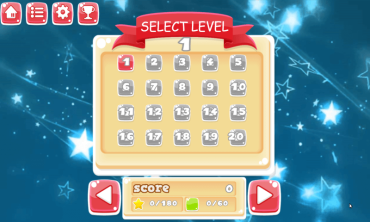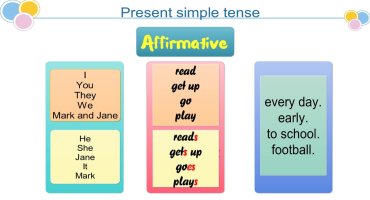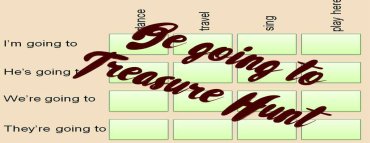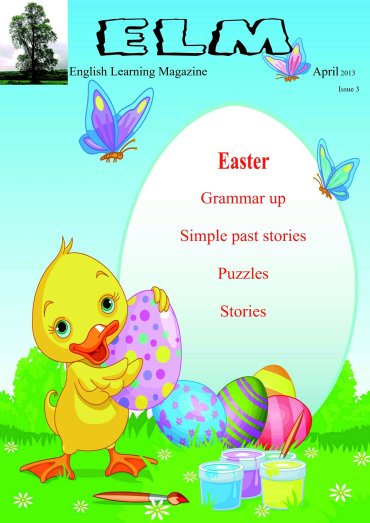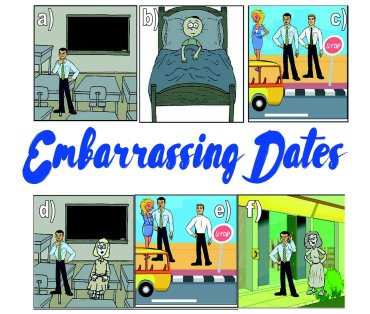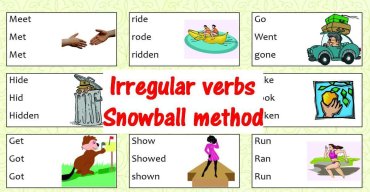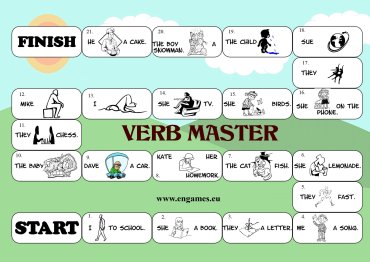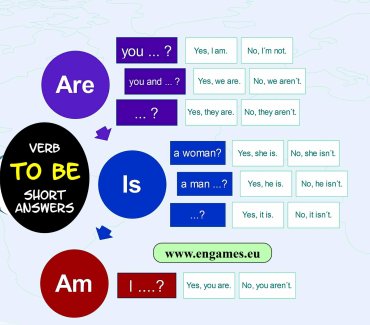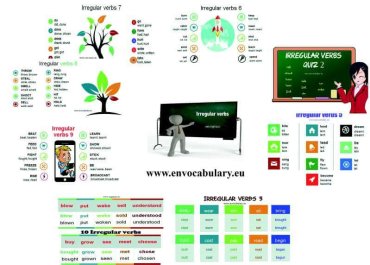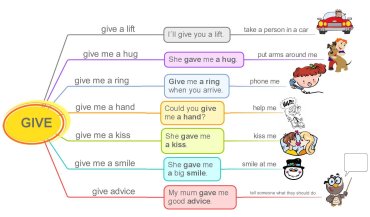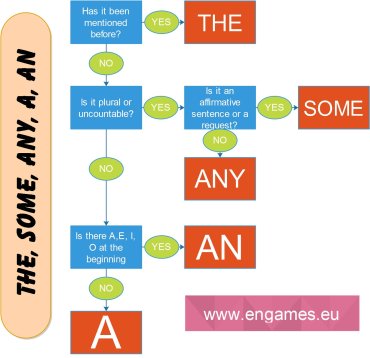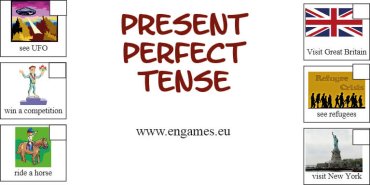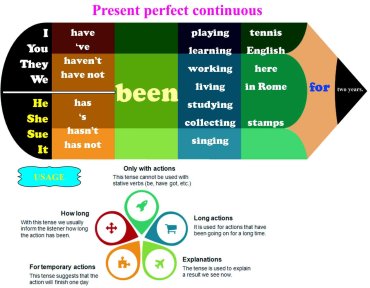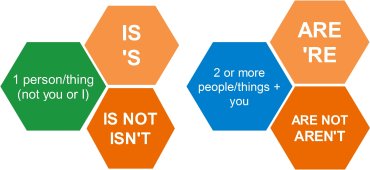Mobile phones are bad! Students spend hours on mobile apps and they do not learn! What can we do about it?
I tried to do something about it. I prepared a responsive website for my students to learn on their mobiles and … they didn´t come.
<!– wp:more –>
But then I created my first android app and everything changed. I became a school hero and students have been showing me their mobiles with my app on them.
And I wondered: Why do they suddenly learn on their mobiles?
ADVERT:
[showmyads]
The answer is simple. Data is expensive and when the students decide to use the internet, they do it to socialize. And let´s be honest, my static website is no competition for sites like Facebook or Instagram.
But as the app does not require the internet connection, it sits in their mobile phones and waits for the moment when the students disconnect. And then the students start to play the vocabulary game. Several factors play their role here. First, students can use their mobile phones, second, no one blames them that they do not learn, and third, they make their parents and teachers happy by playing a mobile app on their phone.
The application – explanation
It is quite simple. There appears a word on the screen in students´ MT and they have to type the word in English. If they answer incorrectly the correct answer is shown, and the word gets repeated after a while.
There are sixty levels and students get points and stars for their performance.
You can download the mobile app at Google Play. It is called “Top 450 slovicek v aj final“.
In my application they learn 450 most frequent words in English. You can see the screenshots here:
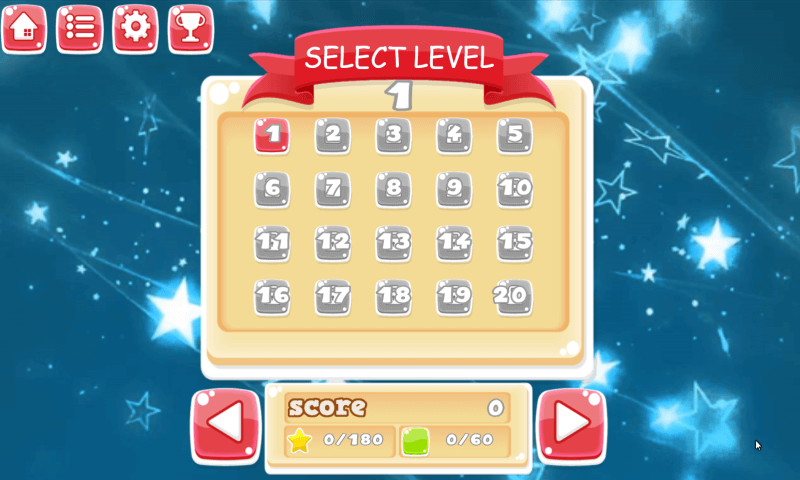
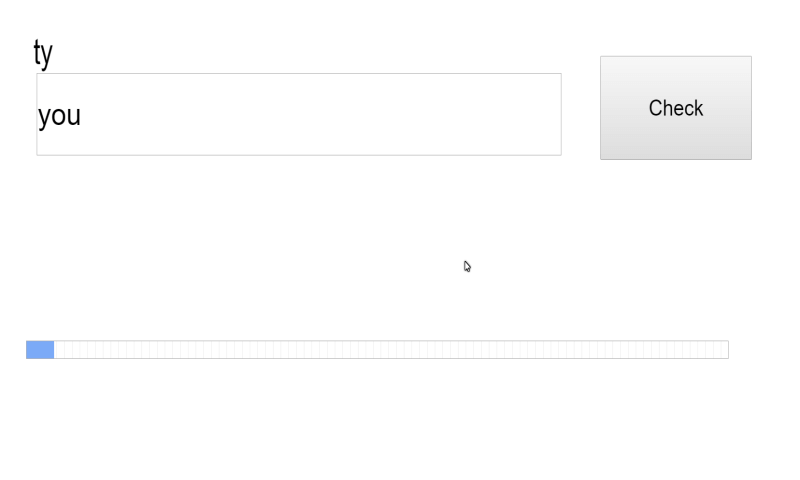

My first mobile app – Free app for you
I will do it for free.
The only thing I want is, that I may later use the text file in any way I want.
Category: English games
In this post I would like to share with you the best activities I know to teach the present simple tense.
To achieve this, I will recycle some of the materials I have already and shared here. However, there are several new materials (for example the infographic) which I designed just for this post.
<!– wp:more –>
ADVERT:
[showmyads]
I hope you find these materials useful and you will use them in your lessons.
Present simple – song
Here are the lyrics to complete:
Present simple songPresent simple – form
The aim of the following activity is to sensitize students to the forms of the present simple tense and to improve their pronunciation.
Play the following rhyme and ask the students to listen and then repeat it. In the last phase, students should read it on their own.
It is a good idea to ask your students to memorise the rhyme.
Present simple – infographic
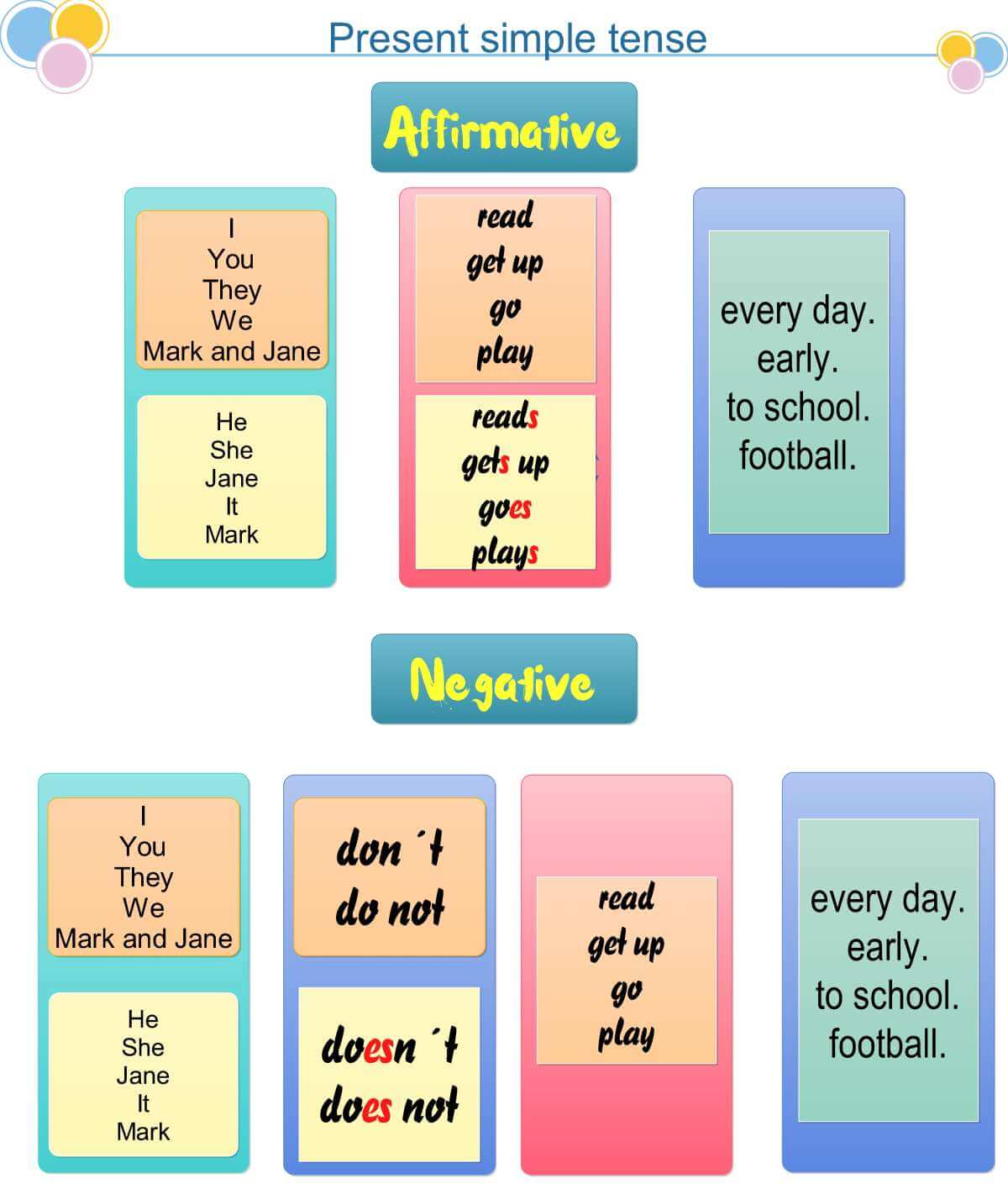
Print the picture for everyone and explain that students should use the ending -s with the third person singular.
You might want to teach the correct spelling of the -s ending, but I do not think it is a good idea. I believe, it is better to expose the students to the language now.
Present simple – story
Print the worksheet, so that every student has a copy. It is best to print the cards on a stronger paper. Ask the students to cut the cards and go through the cards and translate the expressions into the students´ MT. Students write the translation on the other side of each card.
Then students learn the new words using the flashcards.
Once they learn the words, play the following British Council video and ask the students to do the accompanying tasks. I think that tasks 1 and 4 are especially important.
ADVERT:
[showmyadsa]
Collect the texts your students write and correct them to see what problems your students have.
Present simple – grammar exercises
It is a good idea to teach the most frequent verbs in English here. Here are the flashcards for the most frequent verbs in English:
Most frequent English verbsElementary students are taught that there is very little difference between the words MUST and HAVE TO. Little as it may be, it exists. And in this post I would like to give you several rules which will help you decide which one is better in the given sentence.
<!– wp:more –>
ADVERT:
[showmyads]
In this short post you will find an infographic, two online quizzes and a worksheet.
Must or Have to? – infographic
However, in this post I will give you a different explanation. It is based on the explanation given by Jim Scrivener in his book Teaching English Grammar. There he states 5 rules which should help learners decide which verb to use. The rules are summed up in the following infographic.
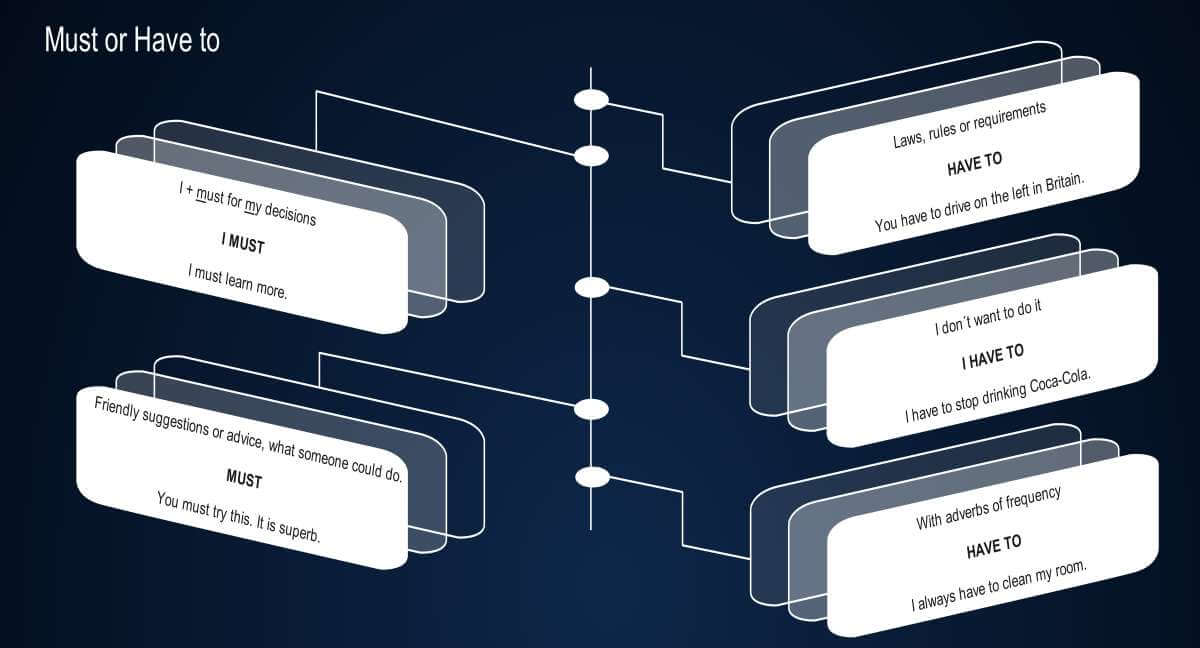
Remember, that you can often use the verb HAVE TO instead of MUST but it may not sound completely natural.
Must or Have to? – Quizzes
If you do not want to use the online version, here is the paper version of the same quiz:
Must or Have to -paper quizMust or Have to – Links
Must and Should – this is one of the most popular posts at this site.
There is a nice board game to practise the verb Must here.
At https://engames.eu/past-tense-of-modal-verbs/ you can find the past tenses of the modal verbs.
And there is a great infographic explaining the usage of the verbs HAVE TO, DON´T HAVE TO and MUST here.
The following set of activities is for false beginners and elementary students of English. The aim of these activities is to practise the usage of the form be going to and reinforcing this form.
<!– wp:more –>
Be going to – Preparation
ADVERT:
[showmyads]
Be going to worksheet
Be going to – Treasure hunt
1. Display the first slide and tell students that they need to find ‘buried’ treasure under one of the squares. Ask them to give you the coordinates of the square by saying the sentence. Click on the squares to reveal what is beneath. Correct pronunciation and elicit the long forms of I’m, He’s, We’re and They’re.
You can download the powerpoint presentation here:
Be going to Powepoint presentation2. Display the second slide and tell the students that now you have put the treasure in a different place and that they can find it by making negative sentences. Once they find the treasure, tell them that they are going to play a similar game in pairs.
3. Hand out exercise 1 from the worksheet. You might want to elicit all the sentences and check pronunciation before the students start working in pairs.
4. Ask the students not to show their paper to anyone and to hide four treasure chests in the grid by writing four Xs. Then they try to find their partner’s treasure as in steps 1 and 2 above. When the guessers find one of the crosses, they should write it in their copy of the grid; when they find a blank square, they should draw a line through it. Let them play for a maximum of five minutes.
5. Display the third slide. This time students find the treasure by making questions.
6. Hand out exercise 2 from the worksheet. The students play the same game as before, but this time they make questions. At the end of this activity they should be familiar with all the forms of ‘be going to’, so now it’s time for how to use it.
Be going to – Future plans
8. Elicit the use of the form – for your plans for the future.
You can use the following infographic to explain the form:
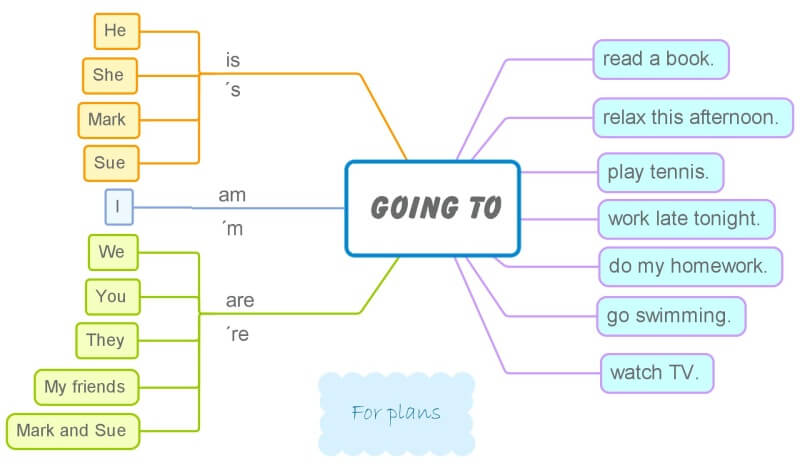
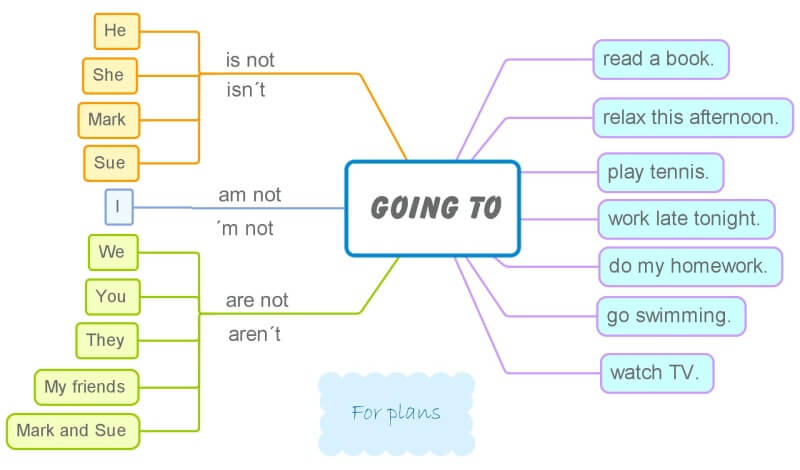
ADVERT:
[showmyadsa]
Be going to – infographic
9. Display the fifth slide, hand out exercise 3 from the worksheet, and ask the students to write down your plans for the given times. After five minutes collect the sentences and check them during the next activity. Suggested answers are given at the bottom of p.5.
10. Hand out exercise 4 from the worksheet and ask the students to draw their plans in the grid. Tell them that they have only five minutes to do this and they mustn´t write words. If they don’t have any plans, they should make them up. In the meantime, check their answers to the previous activity.
11. The students work in pairs to guess what their partner is going to do, using the pictures. They should use yes/no questions and short answers. Demonstrate with one of the students, using your plans on the PowerPoint slide:
A: Are you going to buy a kite next month?
B: No, I’m not.
A: Are you going to fly a kite next month?
B: Yes, I am.
12. Return the students’ sentences from exercise 3 and give feedback.
Be going to – follow up
1. If students need further practice with the form, you could use the following drill:
Say the first sentence and ask the students to transform it using the word you give them. Demonstrate the first one or two.
I’m going to play tennis tomorrow.
you: You’re going to play tennis tomorrow.
football: You’re going to play football tomorrow.
Here is the sequence:
I’m going to play tennis tomorrow.
you / football / watch / they / TV / next week / buy / we / he / a car / she / question / you / he / drive / negative / I
2. Hand out exercise 5 from the worksheet. Check vocabulary before students start the pair work. They then work in pairs to ask and answer the questions.
3. You can find a great infographic and more teaching ideas on be going to here.
4. There are some great ideas on teaching Be going to at British Council site.
Speaking activities are essential in a communicative approach. Most people agree that students should communicate ever since they start learning English. However, it is really difficult to design genuine communicative tasks for low-level students of English. In this post, I would like to share two communicative tasks for beginners. In the first one, students practise the verb HAVE GOT and in the second one they go shopping for clothes. I hope you like them.
<!– wp:more –>
ADVERT:
[showmyads]
Speaking activity – HAVE GOT
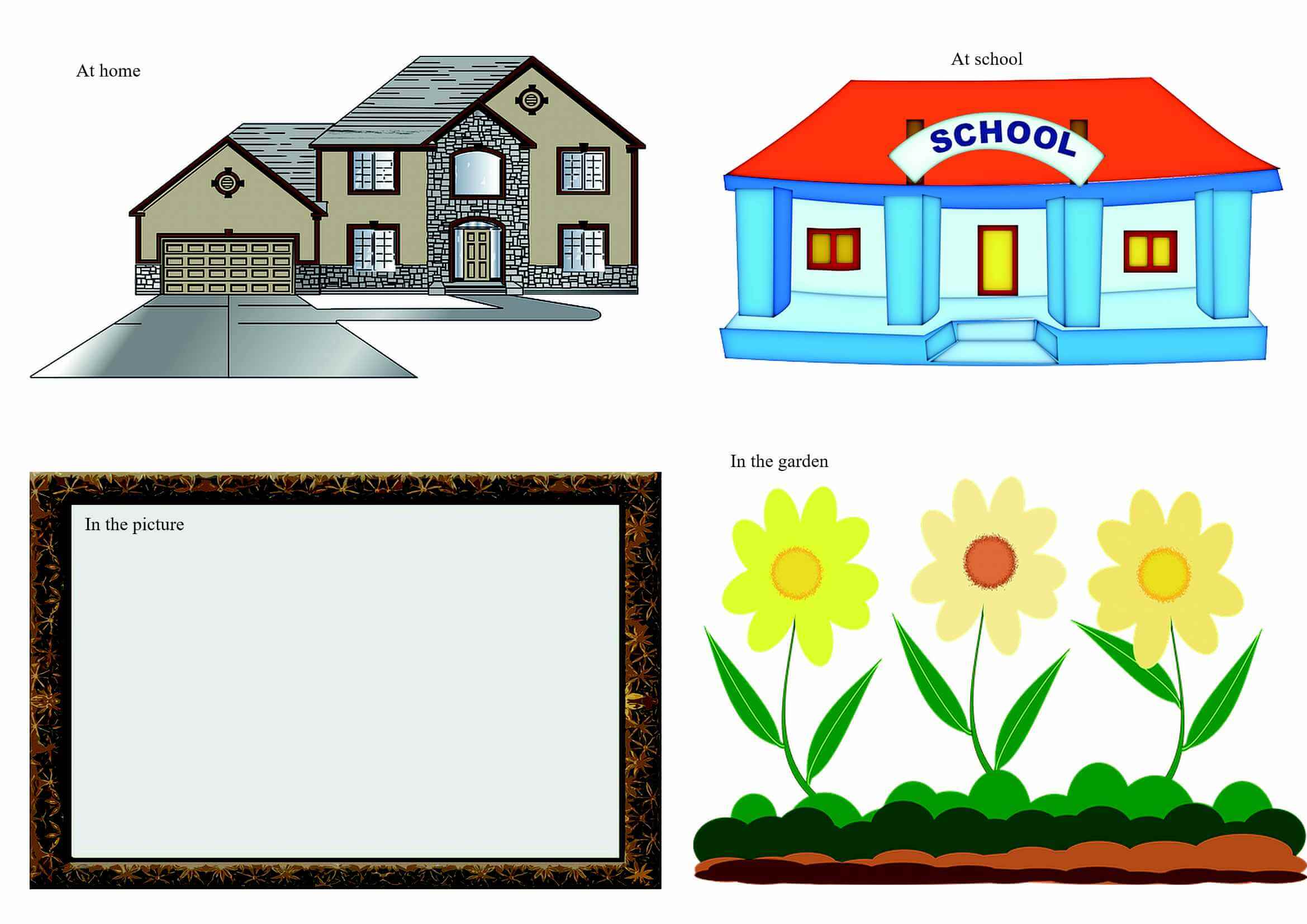
Second, each student needs to cut the following picture into the pictures.
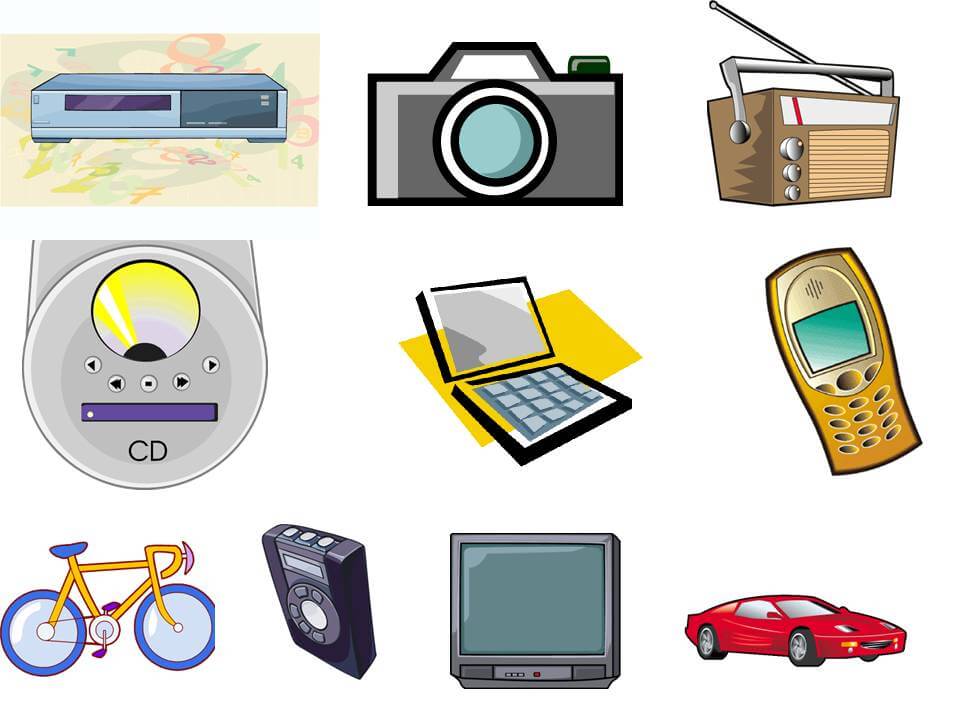
Each student places four of the machines into their picture (one machine is in the garden, one is at home, one is in the picture and one is at school). They must not show their board to anyone.
Students work in pairs and they try to guess what their partner has placed in the places. They have to ask: “Have you got a computer?” If the answer is YES, they go on. “Have you got the computer in the garden?” If the answer is YES again, the thing is removed from the game. If the answer is NO, students swap roles. Students swap roles every time they answer NO.
The winner is the student who removes the four things from their partner’s plan first.
Students love the game.
You can download the worksheets here in pdf file.
Have Got speaking worksheet
Speaking activity – SHOPPING
Print the following worksheet. Students work in pairs and each of them has one half of the worksheet. They must not show their worksheet to their partner and their task is to find out how much they have to pay for the clothes with no price tags. They should use the dialogues in the boxes. Point out that they should use the blue dialogue for the clothes in the blue square and the yellow dialogue for the ones with the yellow background.
ADVERT:
[showmyadsa]
Shopping for Clothes – speaking activity
Speaking activity – your opinion
Which of these activities do you like better:
Easter is coming and many teachers are looking for materials connected with Easter. Here, I am offering a magazine full of materials connected with Easter for learners of English. I hope you like it.
<!– wp:more –>
ADVERT:
[showmyadsa]
Easter – English learning magazine
My first English language teaching activity got published in August 2008. It happened on the site http://www.teachitelt.com. The site regularly sent me the royalties and I created several more activities for them. Unfortunately, recently they sent me an email that the site is going to finish on 30th March 2016. The good thing is that they returned the rights to me and I am allowed to used the materials I created in any way I like and publish them wherever I like. So, here I share the first lesson plan I created. It is called Embarrassing Dates.
<!– wp:more –>
ADVERT:
[showmyads]
Embarrassing dates – warmer
Tell them the following story. It is true story which happened to me, so you can introduce it as a story which happened to one of your friends and colleagues to catch students’ interest.
‘When I was about 17, I used to attend dancing lessons after school. One evening, after a lesson, my schoolmate and I were going home. It was late and it was dark. We came to a bus stop and we were waiting for a bus when I noticed a beautiful blond girl also waiting.
We started talking to her and we soon found out that she went to the same school and that she loved literature, like me. My friend wasn’t interested, but I liked her very much and we talked the whole way back.
I couldn’t sleep that night. I was thinking about her and remembering everything we said. I couldn’t wait to see her again.
So, the next morning I started looking for her, but I couldn’t find her for some time.
In the end I found her in a classroom. I was a bit shocked, because she didn’t look quite as perfect as the night before, but I thought that looks weren’t that important. So we agreed to go shopping that afternoon.
But the afternoon turned out badly. I soon found out that she was really bossy and she ordered me around the shop like a small boy. I felt embarrassed and I was happy to say goodbye. We never met again.’
Now ask the students to look at the pictures and put them into the correct order:

Answer key: c, e, b, a, d, f
Now ask the students to retell the story. You could have them work in pairs and take turns to recount a picture each, or tell it cumulatively, repeating what their partner said before moving on to the next picture. Monitor and correct. At the end, ask one or two students to tell the whole class the story or have students tell it round the class. You could then give whole class feedback.
Embarrassing Dates – vocabulary
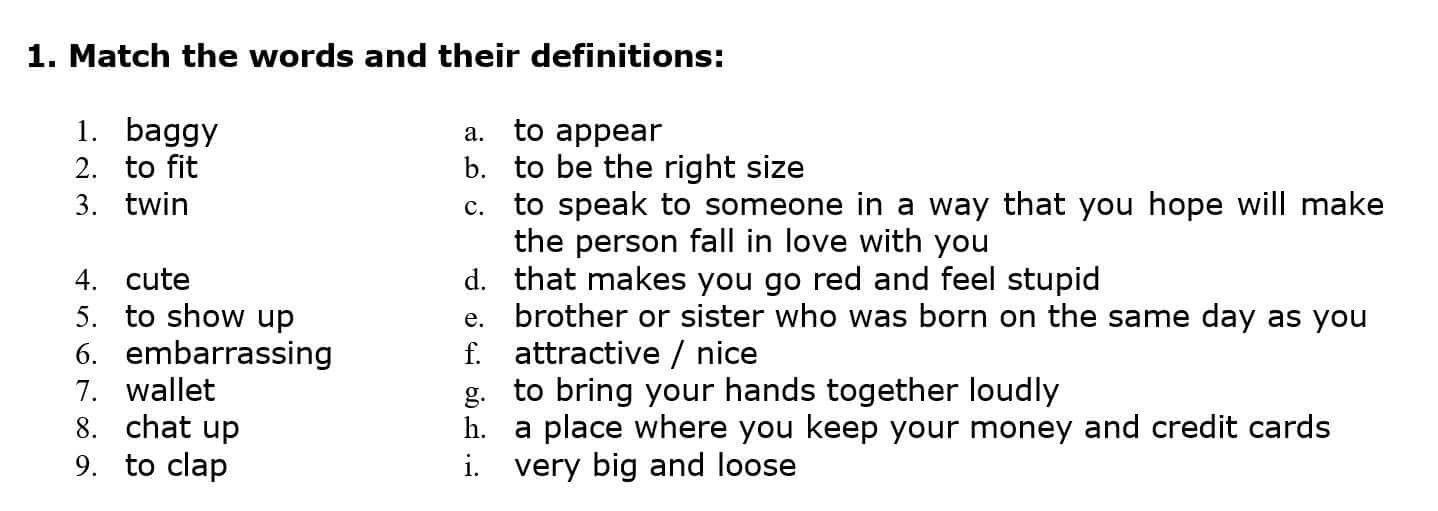
Answer key
1.i, 2.b, 3.e, 4.f, 5.a, 6.d, 7.h, 8.c, 9.g
Sudoku
Sudoku has been very popular recently, but I bet that your students have never done one with words. It gives them practice writing and memorising the new vocabulary. Afterwards, you could have students cover the words in the matching task with a blank sheet of paper and write the words back in next to the definitions.

ADVERT:
[showmyadsa]
Embarrassing Dates – reading
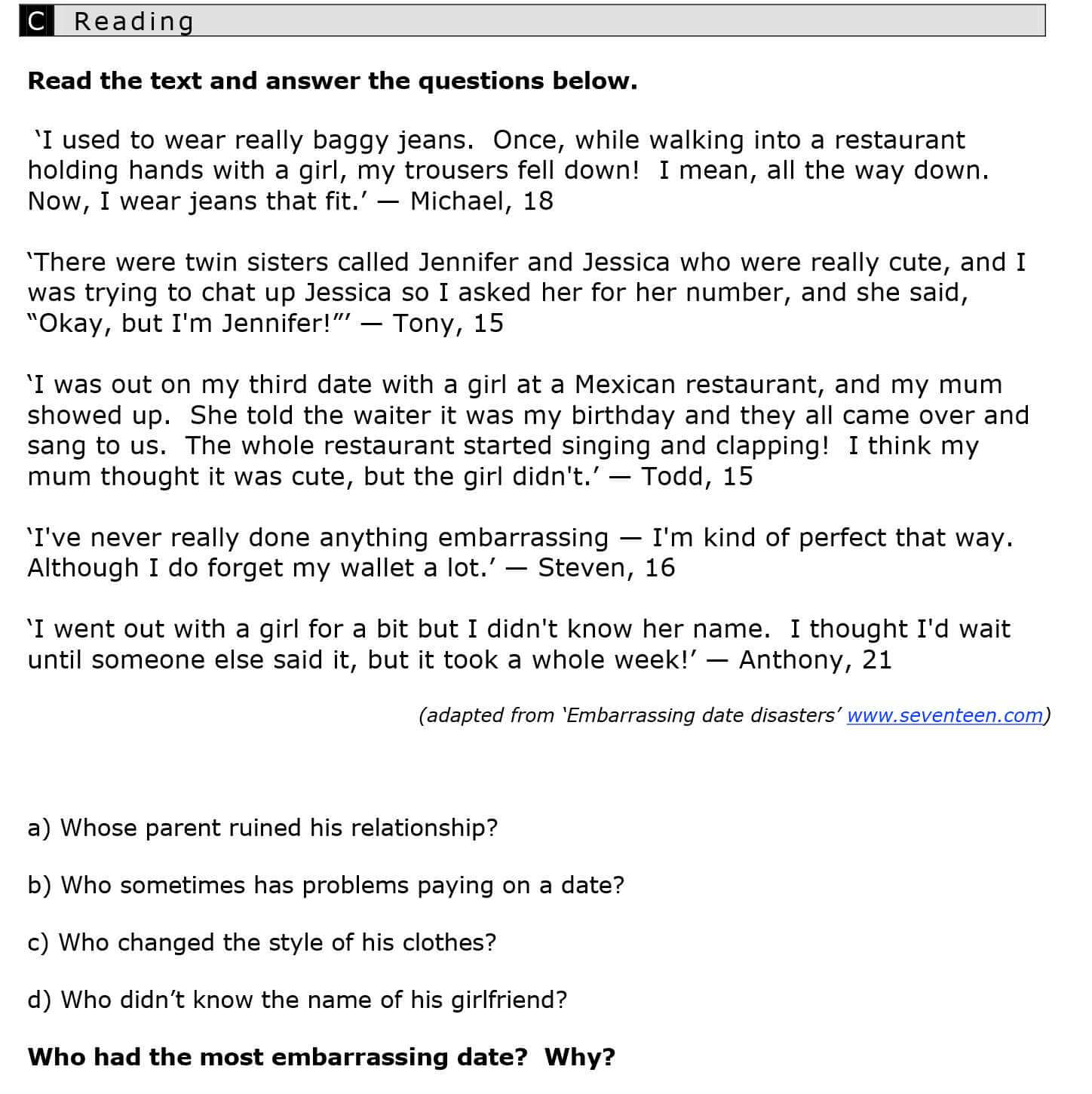
Answer key
1. Todd’s; 2. Steven; 3. Michael; 4. Anthony and Tony
Embarrassing Dates – grammar

Crossword answer key
1 fell down; 2. twin; 3. embarrassing; 4. showed up; 5. chat up; 7. clap; 8. wallet; 9. cute
Solution: first date
Embarrassing Dates – Follow up
You could get older students to speak about their own embarrassing dates.
You can download the full worksheet here:
Embarrassing Dates worksheet
I have always wanted to be a writer. Ever since I was ten I dreamt of publishing a book. And on Saturday, thirty years later I did it. I published a book called 444 Grammar Conversations. This book is for teachers of English to have a set of questions they can use to practise a grammar point in a conversation. And in this post I would like to share with you ten speaking activities, you may find useful when using this book. All the following activities are based on a list of questions.
<!– wp:more –>
ADVERT:
[showmyads]
10 Speaking Activities
a) The simplest speaking activity is, that you print the questions for everyone and students work in pairs and read the questions and answer them.
b) Write the questions just once for each pair and give the copy to one student in the pair. The student with the handout asks the questions and the other answers them.
c) Print one copy for each pair and cut it in half. Each student asks their questions and answers the questions their partner asks.
d) My favorite activity is called Clock speaking. Divide the questions into several sections and write a time instead of a number to each section. Tell the students to find a different partner for each section. Then say what time it is and students have to work with the partner they have arranged. They ask the questions and answer them.
Here you can see an example worksheet for the Clock Speaking activity:

e) Give each student a copy of the questions and ask them to choose 5 questions they like. Then they work in pairs and ask only the questions they chose.
And here, there are five more speaking activities fot the book 444 Grammar Conversations :
f) One student answers a question from the list and the other has to guess which question was answered.
g) Students work in pairs and one student asks and the other has to answer for a set time (e.g. 15 seconds). In this way, students are made to speak longer.
ADVERT:
[showmyadsa]
h) Students ask and answer the questions in pairs, but they can lie. The interviewer has to guess when the speaker is lying.
i) Give each student only two questions from the set. Each student has different questions. Students mingle and ask the questions they have on their slip of paper and they answer the questions the others ask.
j) Forbidden words: Students work in pairs and they ask and answer the questions but they must not use the words YES, NO and I don´t know. (Of course you can select other words).
What do you think of the book:
It is quite easy to form comparatives and superlatives in English. However, without much practice students will make a lot of mistakes.
To provide enough practice for my students I have created the following exercises. There are three gap-fill exercises where students will practise the grammar in context.
<!– wp:more –>
ADVERT:
[showmyads]
In this post, there are three interactive exercises and a word file with the same exercises to practise the grammar.
Comparing in English – infographic
Show it to your students and explain that students first have to decide if the adjective is long or short. If the adjective is just 1 syllable, it is short. If it ends with -y, it is short. Otherwise, it is long.
Once they know whether the adjective is long or short, they can form the superlatives and comparatives correctly. With short adjectives, they add the suffixes -er or -est. With long adjectives, they add more or most in front of the adjective.
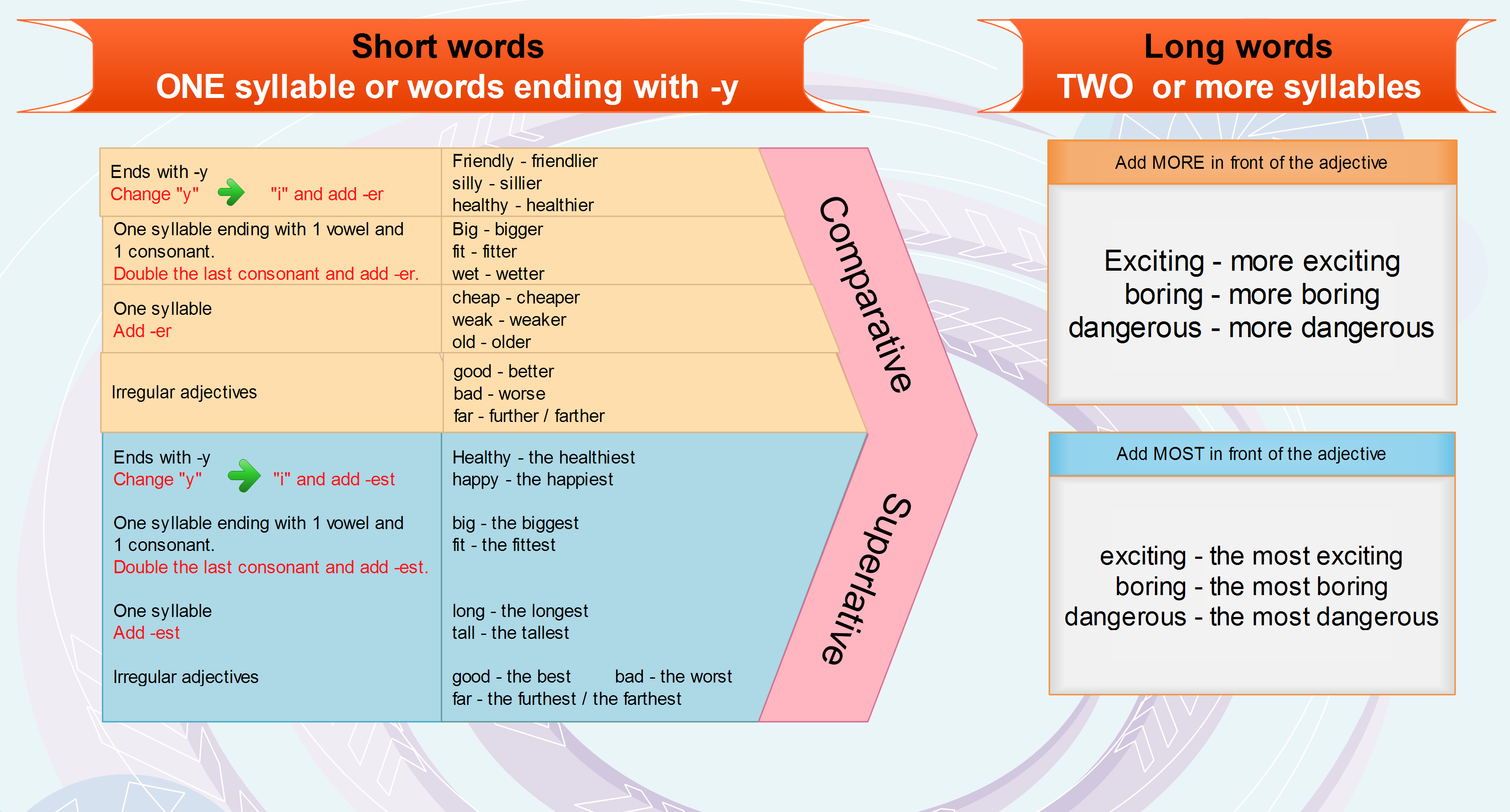
You can find the pdf version of the infographic here:
Comparatives and superlatives infographic – pdf
Comparatives and superlatives – online quizzes
There are three quizzes:
[showmyadsa] Quiz 2 Quiz 3
You can print two of the quizzes and use them in the classroom:
Comparatives and superlatives
Comparing in English – Links
Comparatives and superlatives activities
Comparatives and superlatives speaking activities
Moreover, there are very interesting activities to use in your classroom at British Council site.
I hope you will find this post useful and that your students will practise a lot.
Irregular verbs are probably the most important verbs in English. There are quite a lot of them and they are very common. However, for many ESL and EFL students they are very difficult to learn.
<!– wp:more –>
I have already prepared many activities to teach the irregular verbs to my students. There are irregular verbs from the rap song by Fluency MC, there are several stories to learn the verbs in context and there are many infographics to make the learning a bit easier.
ADVERT:
[showmyads]
Having tried all of these, I have to say that the most effective way of teaching irregular verbs in English is the SNOWBALL method. This method does not promise to teach you 100 verbs in 10 minutes. You have to study the verbs for 10 days in a row to learn these, but then I can guarantee that you will remember more than 90% of these verbs. So why don´t you try it for yourself?
Snowball method – How does it work?
Moreover, if you make a mistake, the verb is repeated again until you get it right or until you make 3 mistakes.
Irregular verbs – infographics
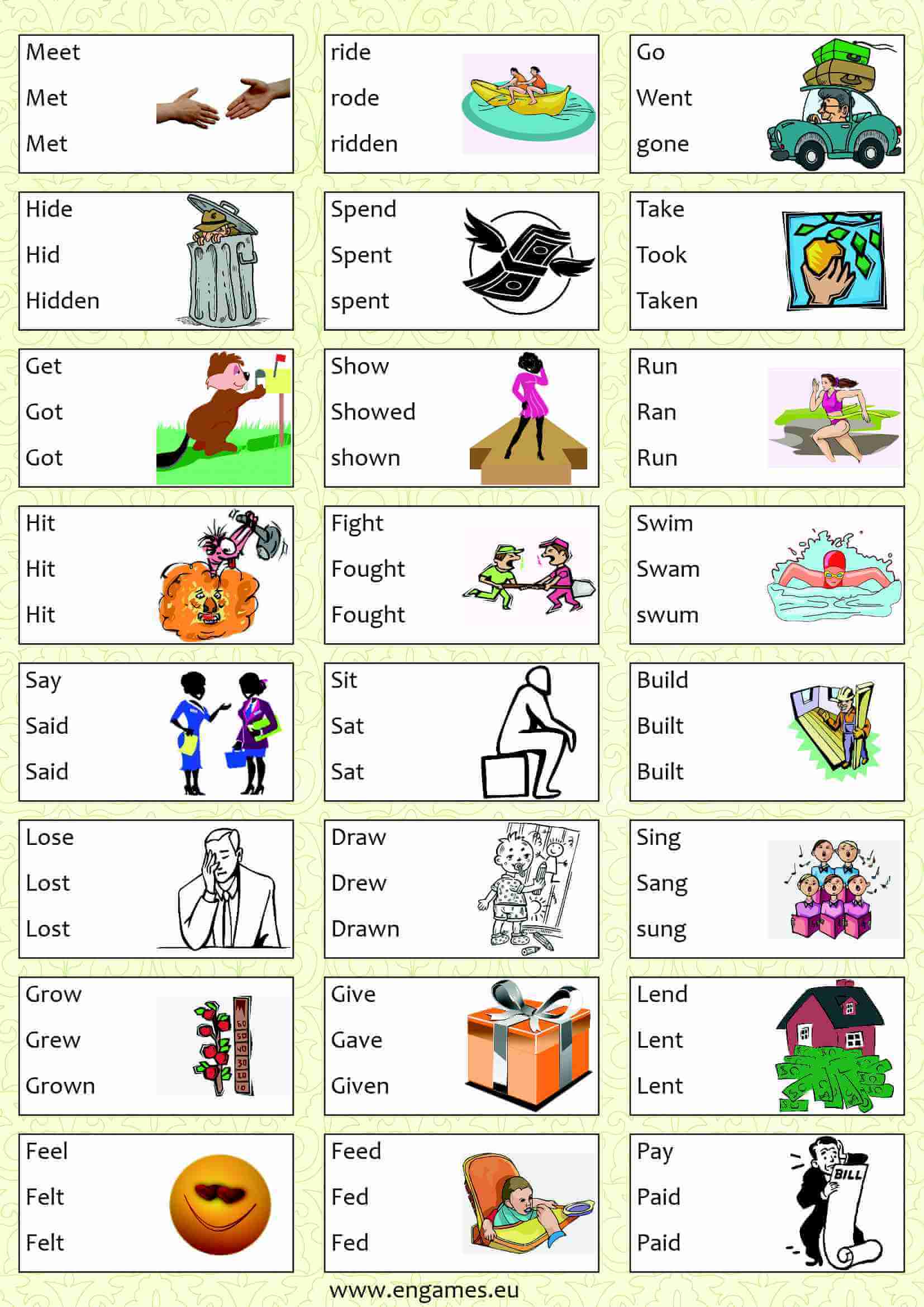
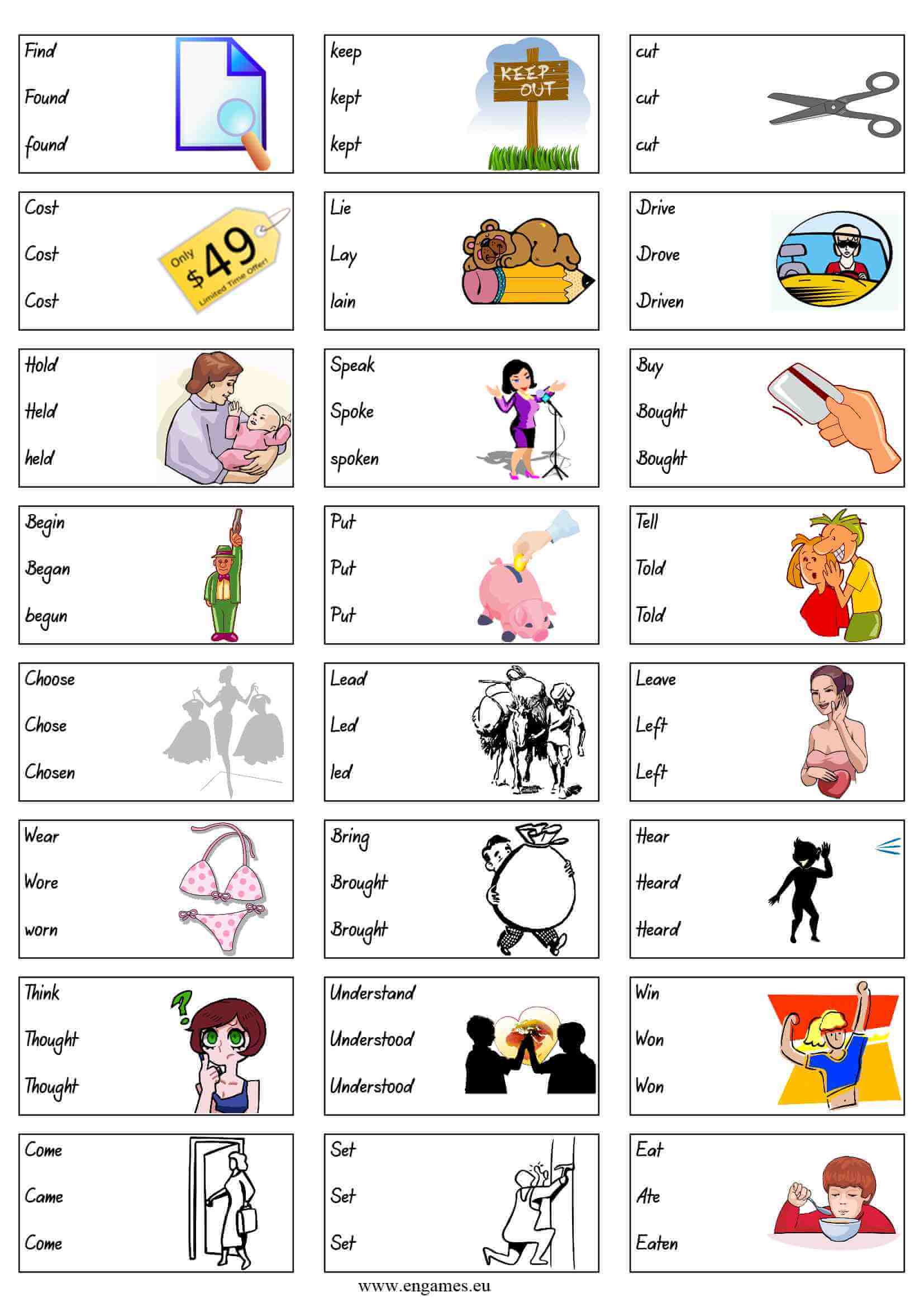
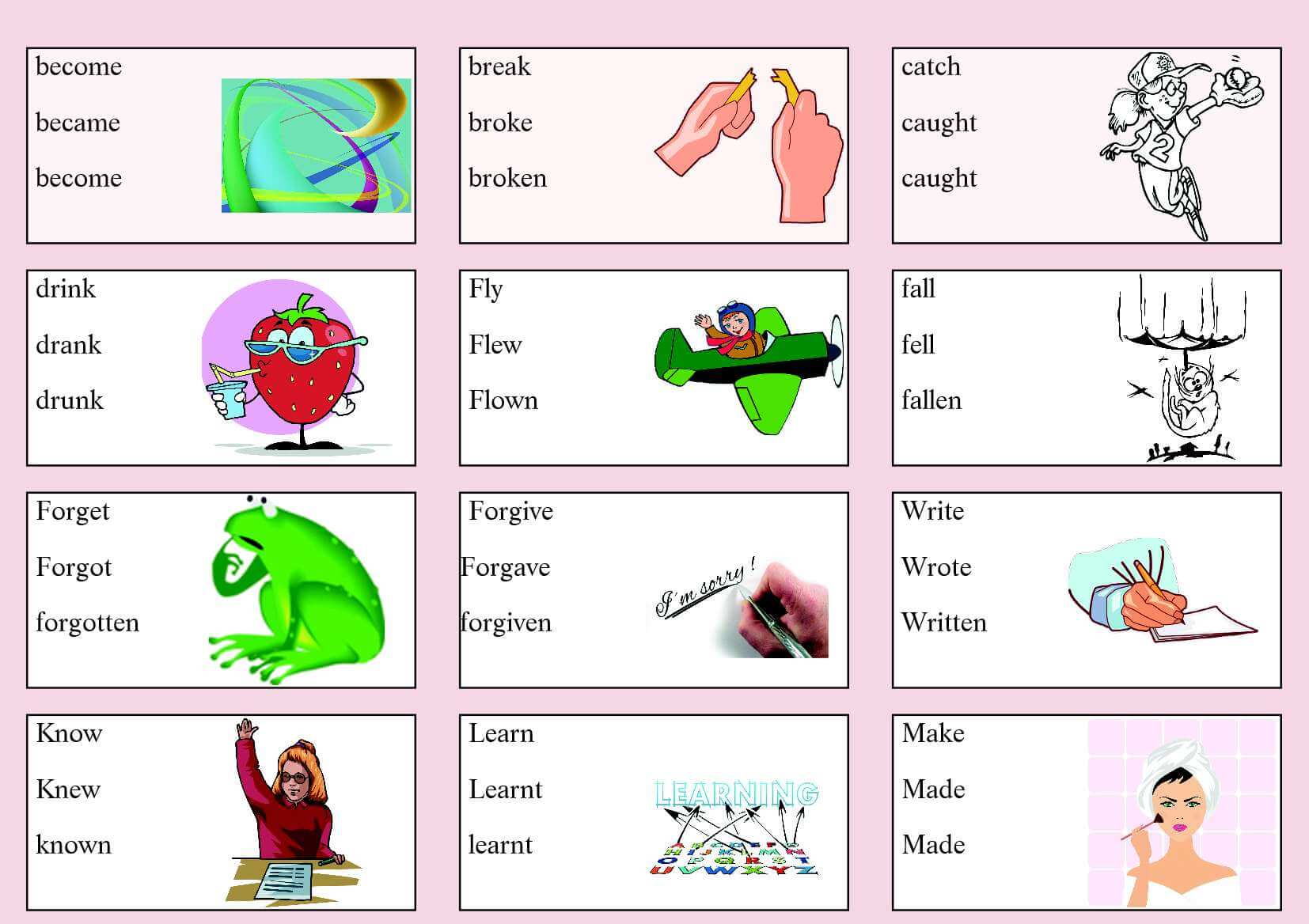
Irregular verbs – Snowballs
Do Snowball 2 the next day. Then do Snowballs 3-10 one each day. Snowball 1 – full screen Snowball 2 – full screen Snowball 3 – full screen Snowball 4 – full screen Snowball 5 – full screen ADVERT:
[showmyadsa] Snowball 6 – full screen Snowball 7 – full screen Snowball 8 – full screen Snowball 9 – full screen Snowball 10 – full screen
Verb master board game is intended to replace drills. The aim of this game is to help students learn to form verb tenses. While drills are boring, board games are interesting and fun. Thus, students practise the grammar forms and enjoy it.
<!– wp:more –>
The great advantage of the Verb master game is the fact that the game is nearly universal. It is designed in such a way that you can practise nearly any English tense there is. So you just print the game once and then you can use it as many times as you like or your students like.
ADVERT:
[showmyads]
Verb master – board game

You can download the pdf file here: Verb master game – pdf file
The great advantage of the game is, that you can arrange students into various groups of various sizes.
Ask students to find something that will serve as a counter. Hand out one game and one die for each group.
Tell students what tense they have to form, for example, present continuous. Students throw the dice and move along. When they finish their move, they have to say the sentence they landed on using the given tense. If they form the sentence correctly, they stay where they are. However, if they make a mistake, they have to go back to the start. (This rule might seem a bit harsh, but it makes the game more exciting and students pay more attention to the sentences their partners are saying.)
I always prepare the keys for each group and I hand them out before the game starts. You will find several of the keys below.
ADVERT:
[showmyads]
[wptabsy]
[tab]Pr. continuous[/tab]
[tab]Past continuous[/tab]
[tab]Past simple[/tab]
[tab]Pr. simple[/tab]
[tabcontent]1. I am going to school.
2. She is reading a book.
3. They are writing a letter.
4. We are singing a song.
5. They are running fast.
6. She is drinking lemonade.
7. The cat is eating fish.
8. Kate is doing her homework.
9. Dave is driving a car.
10. The baby is sleeping.
11. They are playing chess.
12. Mike is sitting.
13. I am swimming.
14. She is watching TV.
15. She is feeding birds.
16. She is talking on the phone.
17. They are dancing.
18. Sue is flying.
19. The child is crying.
20. The boy is building a snowman.
21. He is making a cake.
[/tabcontent]
[tabcontent]1. I was going to school.
2. She was reading a book.
3. They were writing a letter.
4. We were singing a song.
5. They were running fast.
6. She was drinking lemonade.
7. The cat was eating fish.
8. Kate was doing her homework.
9. Dave was driving a car.
10. The baby was sleeping.
11. They were playing chess.
12. Mike was sitting.
13. I was swimming.
14. She was watching TV.
15. She was feeding birds.
16. She was talking on the phone.
17. They were dancing.
18. Sue was flying.
19. The child was crying.
20. The boy was building a snowman.
21. He was making a cake.
[/tabcontent]
[tabcontent]1. I went to school.
2. She read a book.
3. They wrote a letter.
4. We sang a song.
5. They ran fast.
6. She drank lemonade.
7. The cat ate fish.
8. Kate did her homework.
9. Dave drove a car.
10. The baby slept.
11. They played chess.
12. Mike sat.
13. I swam.
14. She watched TV.
15. She fed birds.
16. She talked on the phone.
17. They danced.
18. Sue flew.
19. The child cried.
20. The boy built a snowman.
21. He made a cake.
[/tabcontent]
[tabcontent]1. I go to school.
2. She reads a book.
3. They write a letter.
4. We sing a song.
5. They run fast.
6. She drinks lemonade.
7. The cat eats fish.
8. Kate does her homework.
9. Dave drives a car.
10. The baby sleeps.
11. They play chess.
12. Mike sits.
13. I swim.
14. She watches TV.
15. She feeds birds.
16. She talks on the phone.
17. They dance.
18. Sue flies.
19. The child cries.
20. The boy builds a snowman.
21. He makes a cake.
[/tabcontent]
[/wptabsy]
Verb master board game is designed to help students practise forming verb tenses in English. You can find several other board games at our website. There is a Halloween game and Superlatives and comparatives board game. I hope you will find them useful.
I have spent a lot of time formulating a simple explanation how to form short answers to questions with the verb TO BE. You can find my previous attempt here. While the previous explanation did not work very well, this time, I feel that it is so simple that even the less gifted students understood it. I hope it will work for your students too. Please let me know.
In this post, there is a simple infographic explaining the usage of the short answers, and a speaking grammar activity to practice the grammar.
Short answers – infographic
To form the short answers correctly, students have to start from the beginning of the question. The first word is crucial.
If the question starts with AM, then the answer is either YES, YOU ARE. or NO, YOU AREN´T.
If the question begins with IS, then the students have to see, what follows. If it is followed by a woman, then the answers are YES, SHE IS or NO, SHE ISN´T. If IS is followed by a man then the answer is YES, HE IS or NO, HE ISN´T. In all other cases, the answers are YES, IT IS. or NO, IT ISN´T.
If the question starts with the word ARE then you have to see what follows it. If it is followed by YOU AND, the answers are YES, WE ARE. or NO, WE AREN´T. If the word ARE is followed by YOU without AND then the answers are YES, I AM or NO, I´M NOT. In all other cases, the correct answers are YES, THEY ARE or NO, THEY AREN´T.
The explanation might sound a bit complicated, but it is quite clearly depicted in the infographic.
ADVERT:
[showmyads]
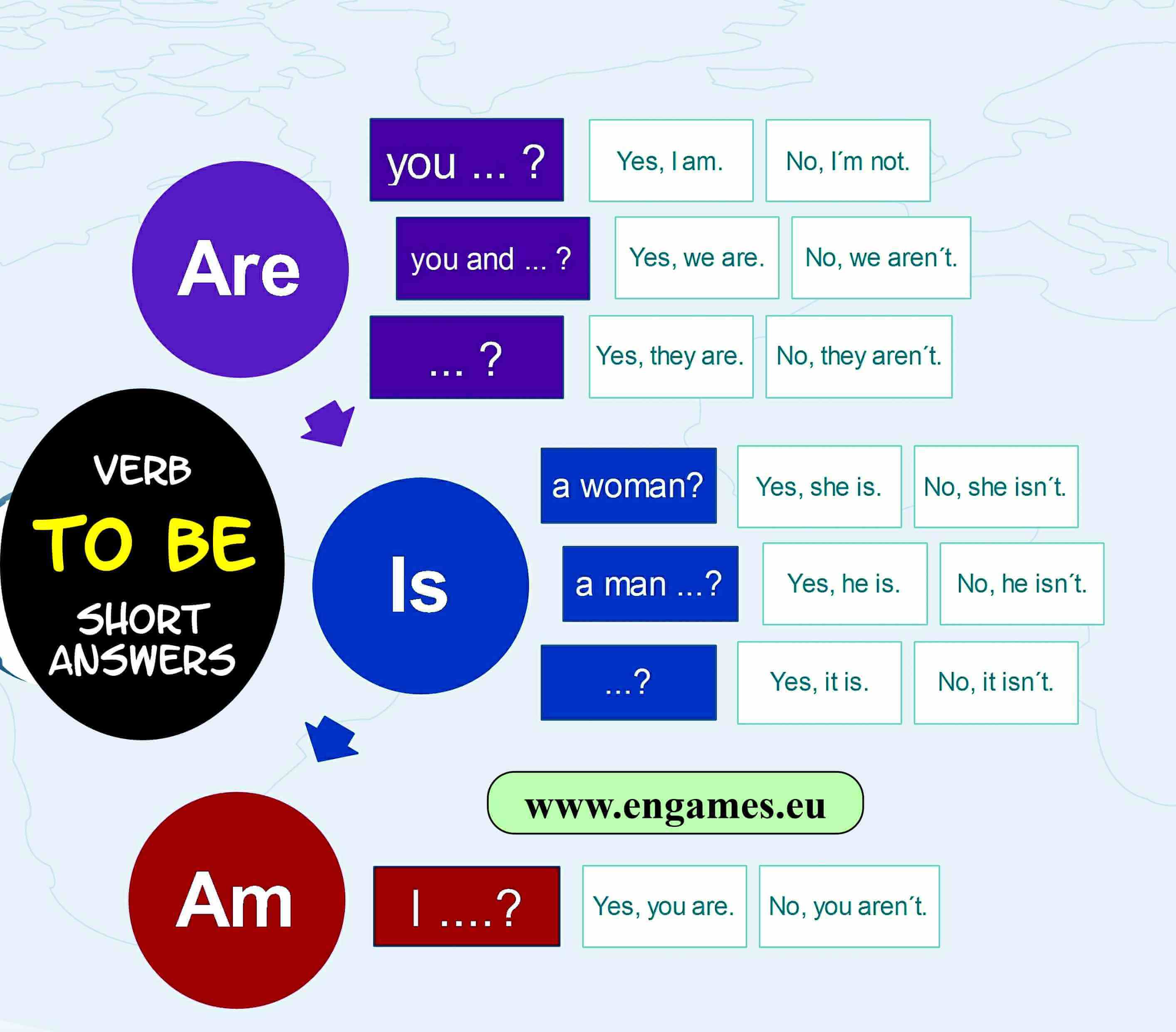
Short answers – speaking activity
The activity is called pair cards. Students work in pairs. Print the following worksheet and give each student in the pair one half of it. Ask the students to work on their own and fill the free spaces with short answers to the questions.
After this, one of the students folds the paper in such a way that they cannot see the short answers. They read the questions aloud and say the short answers. Their partner sees the answers are correct and corrects as necessary. Three minutes later they swap.
Short answers – conclusion
Did the inforgraphic and speaking activity work?
After teaching for fifteen years, it seems that it does not matter how much and well the teacher teaches, it is the student who must learn. I have already published many methods of teaching irregular verbs. There are posts on teaching irregular verbs with a rap song, there are posts with many games and stories where the irregular verbs are used in context. And the result? My students do not know the irregular verbs! If the students do not learn the verbs, they do not know them.
ADVERT:
[showmyads]
This of course does not mean that we should stop making our lessons as interesting as possible. No! It means that we should give students a chance to learn the verbs in an effective way themselves. That was why I started to learn another foreign language. And I found out that the best method to learn new vocabulary was the one which I call SNOWBALL.
Snowball method
This means that each word gets repeated at least six times and if the student does not know it, it gets repeated more frequently.
And I used this method to teach the irregular verbs. There are 100 most frequent irregular verbs in English and if you do one snowball every day, each irregular verb will get repeated at least 6 times.
As the answers are evaluated by a computer, DO NOT USE CAPITAL letters and divide the words with a comma (no pause after the comma).
ADVERT:
[showmyadsa]
In this post, I am going to offer you materials to teach the BREAK and GIVE collocations. This post is different in one aspect, though. This time, I will give you a series of pictures which you can download and combine into your own worksheets.
The advantages of this approach are obvious. You can decide what you are going to teach and what materials you will use. You can throw away the things that do not work for you and add those you like.
Advert
[showmyads]
To insert the pictures into your worksheet, right click the picture and download it. Then insert it into your document and make it bigger or smaller as you need.
BREAK and GIVE Collocations – infographic
BREAK Collocations
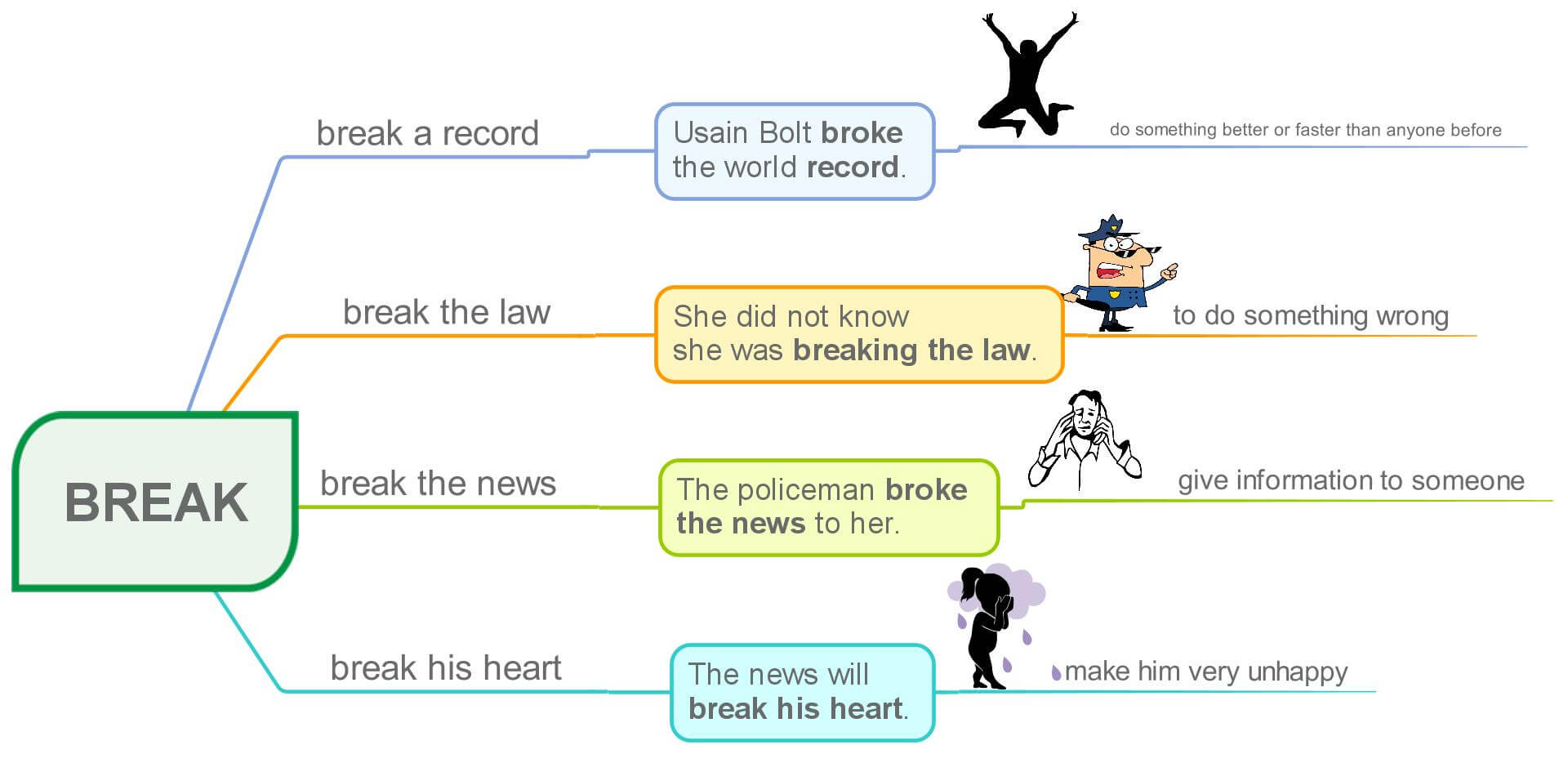
GIVE Collocations
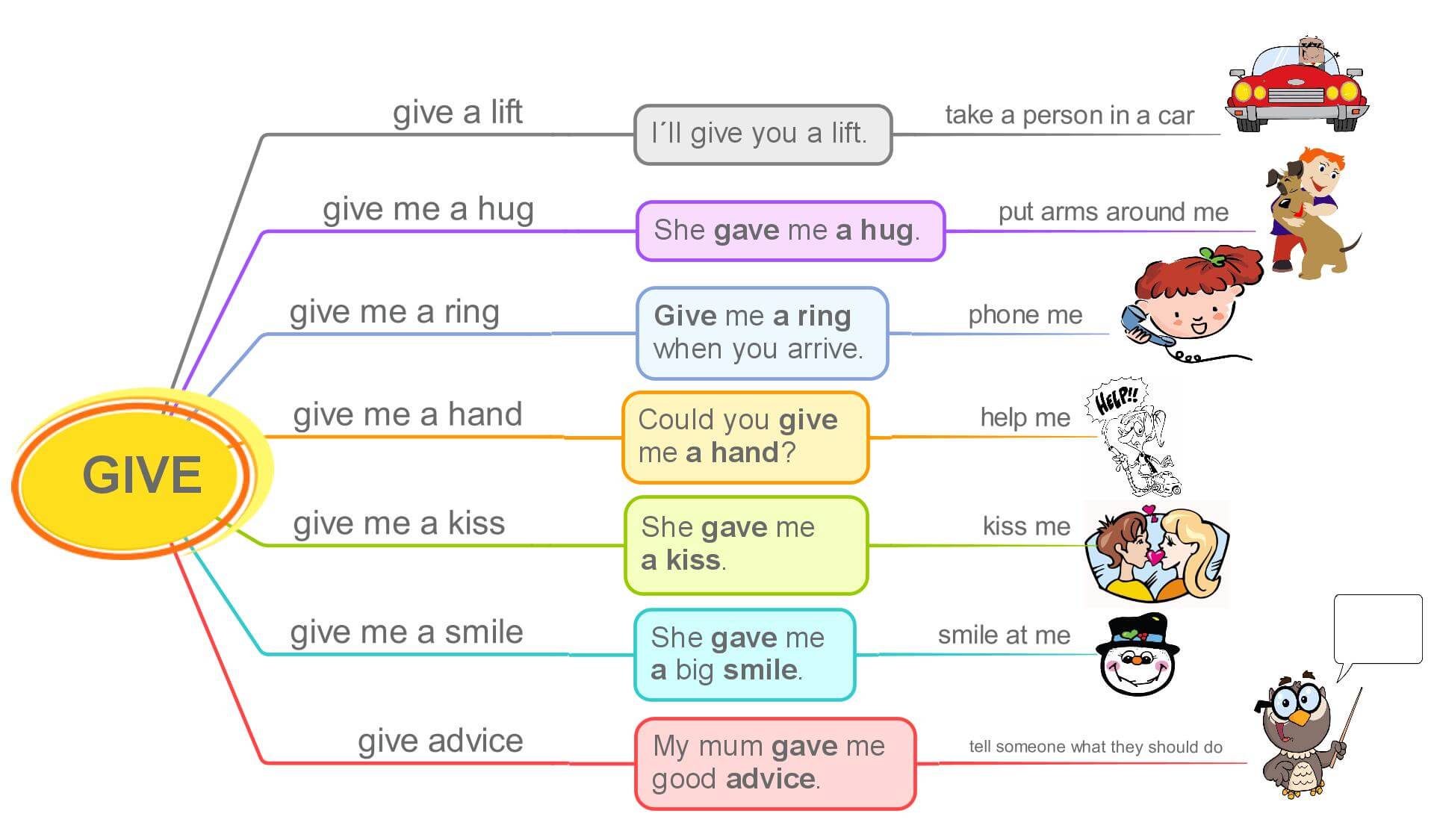
BREAK and GIVE Collocations – Speaking
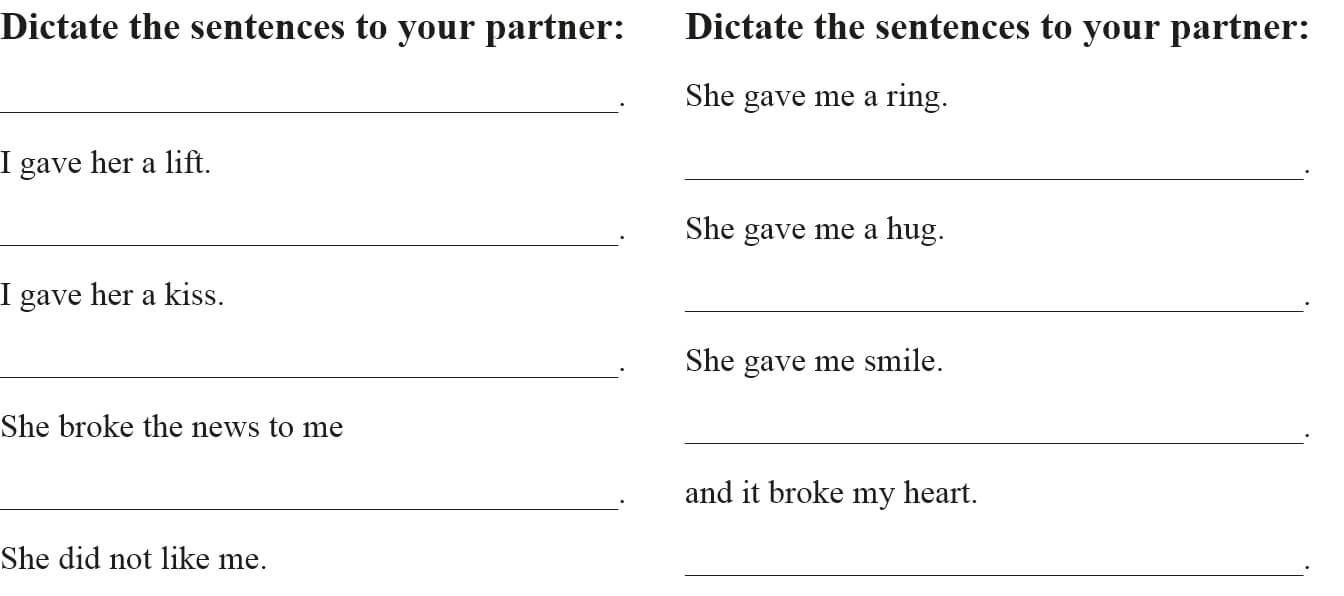
The other speaking activity is done in pairs too. Students read the questions for their partners and they answer the questions.

BREAK and GIVE Collocations – Exercises
Advert
[showmyadsa]
 The key: give a kiss, break the law, give him a hug, give me a lift, break the record, break her heart, give me advice, give him a hand, give me a smile.
The key: give a kiss, break the law, give him a hug, give me a lift, break the record, break her heart, give me advice, give him a hand, give me a smile.In the second exercise students should complete the sentences with the phrases from the exercise 1.
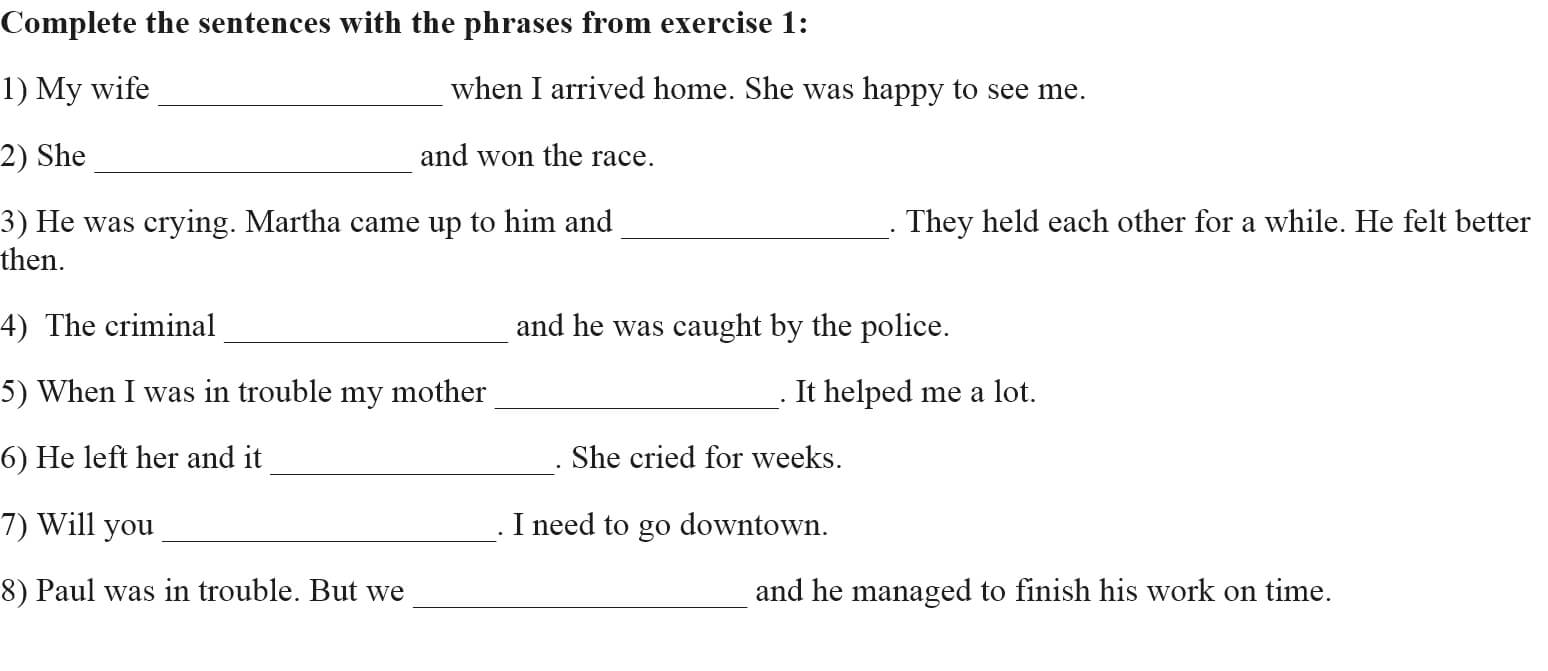
The key: 1. gave me a smile/gave me a kiss 2. broke the record 3. gave him a hug 4. broke the law 5. gave me advice 6. broke her heart 7. give me a lift 8. gave him a hand
In the third exercise students should match the collocations and the definitions.
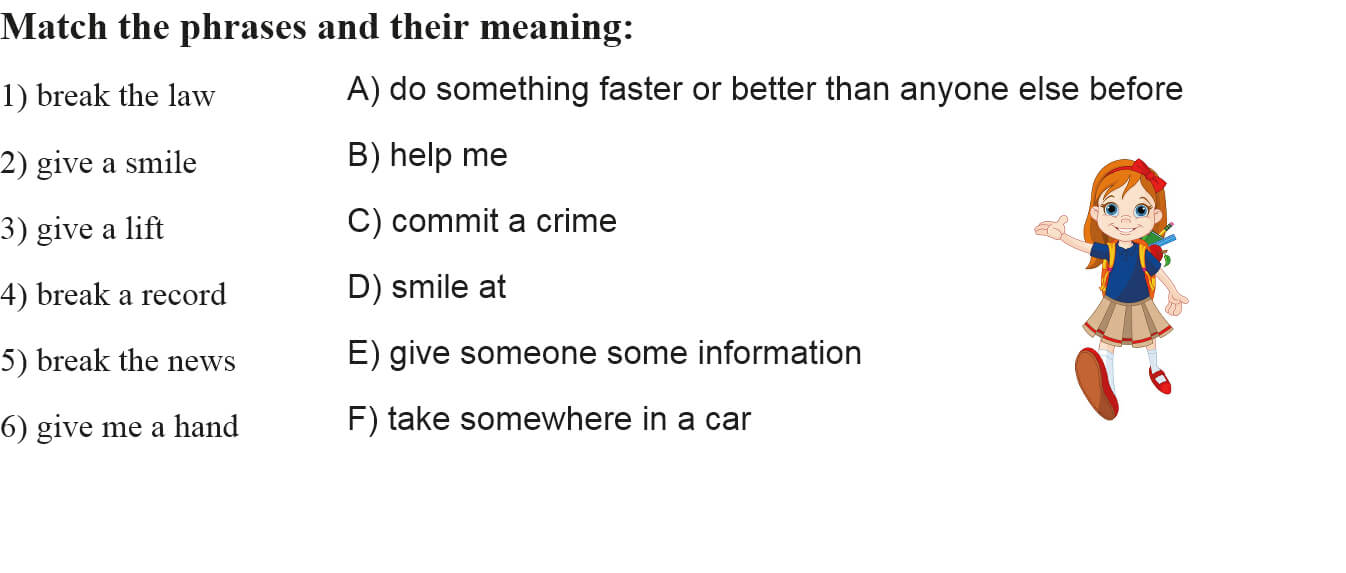
The key: 1.C 2.D 3.F 4.A 5.E 6.B
In the fourth exercise students should complete the second sentence with a phrase that has the same meaning as the expression in the first one.
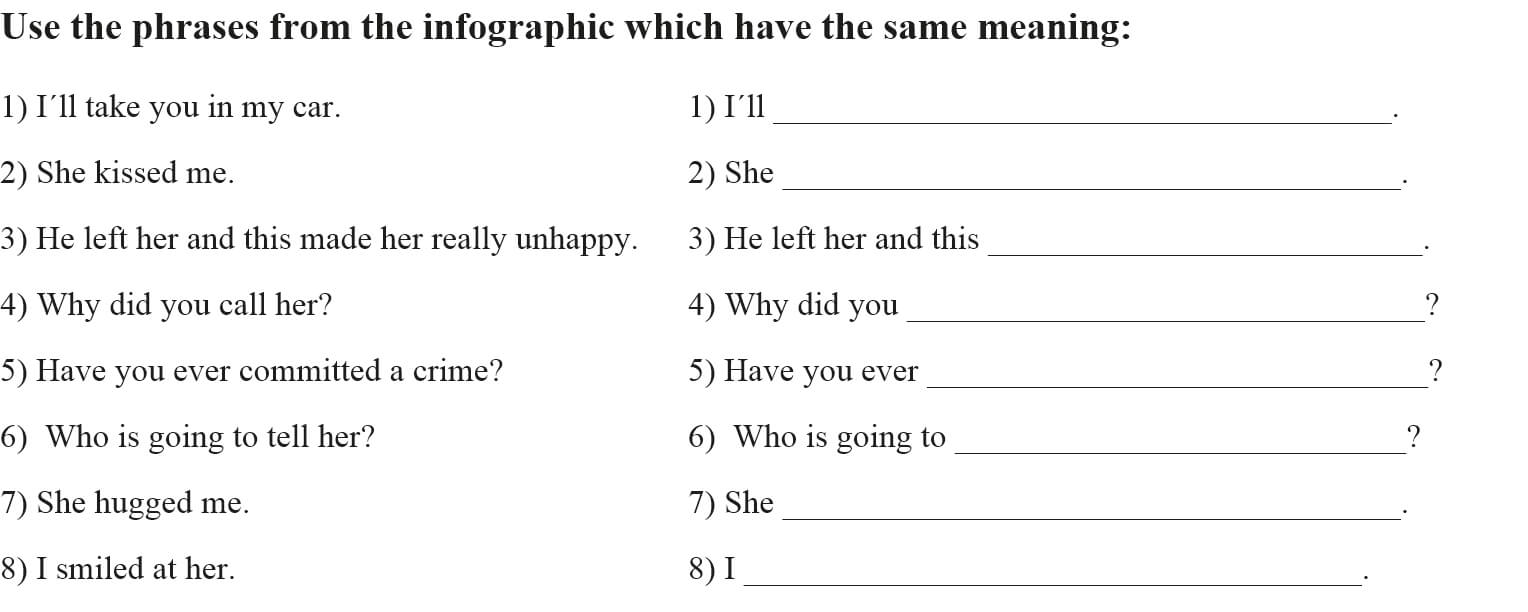 The key: 1. give you a lift 2. gave me a kiss 3. broke her heart 4. give her a ring 5. broken the law 6. break the news to her 7. gave me a hug 8. gave her a smile
The key: 1. give you a lift 2. gave me a kiss 3. broke her heart 4. give her a ring 5. broken the law 6. break the news to her 7. gave me a hug 8. gave her a smile BREAK and GIVE Collocations – conclusion
I hope you will find this new format really useful. In this way, you can easily create your own worksheets to teach the collocations with BREAK and GIVE.
Together with Fluency MC, we have already published several posts. You can find here four posts on irregular verbs and two posts on collocations with the verb HAVE. Fluency MC always comes with a great rap song and I create a mind map and several activities to accompany it. And this time, he came with a song featuring phrases with GET.
ADVERT:
[adinserter block=”1″]
In this post, there is a wonderful rap song on collocations with the verb GET, two mind maps and three games to give you a chance to teach or learn these.
Phrases with get – song
The song is by Fluency MC. Fluency MC also offers a free starter course. Join Fluency MC’s free starter course here and also get his free YouTube songbook! http://fluencymc.com/starter-course/
Phrases with get – mind maps


Once your students feel they know and understand the phrases, it is time to practise their vocabulary.
Phrases with get – games
The first game is called Time Guess. Your task is to write the correct phrase and then stop the countdown at the moment it reaches O (zero). The closer to zero you get the more points you get.
Phrases with Get – Dice Game ADVERT:
[adinserter block=”2″] The third game is called Guess the Length. Again, write the correct phrases and then guess how long the line on the screen is. The better guess the more points for you.
Phrases with Get – Guess the Length
Phrases with get – conclusion
When you teach the concept of countability in English, students have to learn to use the words A, SOME, THE, ANY, AN in front of the nouns correctly. To decide correctly, students have to take several mental steps.In this post I explain the mental process and I offer your students a chance to practise it in several games.
ADVERT:
[showmyads]
In this post you will find a simple infographic, which explains the thinking process. Moreover, there are three brand new games in which students can practise the grammar.
A SOME THE ANY AN – infographic

If the students have already spoken about the thing, then we have to use the article THE. If not, then they have to ask whether the noun is in plural or uncountable. If any of the answers is Yes, then two more questions have to be asked. Is the sentence a request or an affirmative sentence? If the answer is YES, then SOME have to be used. If the answer is NO, then ANY have to be used.
If the noun is not in plural or uncountable, then A or AN is used. AN is used if a vowel is pronounced at the beginning of the noun. Otherwise A is used.
The process might seem a bit complicated when you read the text, but my students found it very easy when they could use the infographic.
A SOME THE ANY AN – games
The first game is called Shooting Game. Your task is to read the sentence and shoot the correct answer. To shoot the word, just click it. Speed matters and you will see your score at the end of the game. Will you be better than me?
Shooting GameThe second game is called Dice Game. Your task is to type A, SOME, THE, ANY or AN (do not use the capital letters) and then stop the dice. The more points the dice show the more points you get. Moreover, if both the dice show the same number, you get a bonus – 10 points.
Dice Game ADVERT:[showmyadsa] The third game is called Time Guess. Your task is to complete the sentence with the correct word and then click the button STOP at the moment you think the countdown got to zero. The closer to zero you get the more points you get. Time Guess
Poll – Which game do you like best?
Which game do you like best?
The present perfect tense is one of the most difficult tenses for learners of English. It is not easy to form the tense correctly as you need the verb HAVE or HAS and the past participle. Moreover, the usage is very specific and many students feel that they could do with the past simple tense only. Thus teaching this tense is not easy.
ADVERT:
[showmyads]
In this post I do not aim to explain anything about the present perfect tense. Here, I would like to share a set of activities to help you teach this tense. You will find here two speaking activities and a worksheet with five more activities to help your students master the present perfect tense.
Present perfect tense – speaking activities
The first activity is a very simple one. It should be used if your students know just how to form the present perfect tense and you want to practise it with them. Print the first exercise and cut it in the middle. The students have to write whether they HAVE or HAVE NOT done the activities in the pictures. (Check that the students form the tense correctly).
Then students work in pairs and read their sentences to their partners. They listen and tick the activities their partner has done.
In the last phase students write the sentences about their partner.
The second activity is called Clock speaking. I has been very successful in my classes and it always leads to a lot of speaking in English.
Print the second page of the worksheet and hand it out. In the first part students have to arrange a partner for each time. Set the following rules:
- You may have only one person for each time.
- Write the name of your partner next to the time.
- You cannot have the same person on the paper twice.
Do not worry about the chaos. In the end there will be some people who will not have a partner for one or two of the times. Elicit the times and pair the students yourself.
Then call out one of the times. The students find their partner for the time and ask the questions for the given time. They ask the questions in italics only if their partner answers yes to the first question (emphasize this). After a couple of minutes call another time.
Present perfect tense – speakingPresent perfect tense – worksheet
The first activity is a crossword. Students should fill in the past participle of the verbs.
The second activity is a gap fill. Students should choose the correct option for each sentence.
In the third activity students should fill in HAVE or HAS.
In the fourth activity students have to write the past participle of each verb.
ADVERT:
[showmyadsa]
In the fifth activity students have to complete the text either with the present perfect tense or the past simple tense.
Present perfect tense – links
If you decide to teach the activities above, certainly start with the following song.
This is my first post on writing. I have not written a post on writing because my students do not like to write and I felt that the textbook activities were enough for them. However, as I have to observe my younger colleagues, it so happened that I saw them teaching the same thing twice. And as I got bored I started to create a lesson that I would teach using the same topic. And this post is the result of the activity.
ADVERT:
[showmyads]
The aims of the lesson are these:
- To write a letter about their favourite toy with young learners.
- To learn some basic phrases for writing a letter.
- To practise their reading skills.
To achieve these objectives, I have prepared a reading activity, a vanishing drill and a worksheet with several exercises. I hope you find them useful.
Writing a letter – reading
Print the following worksheet. You need to print it in colour, otherwise your learners will not be able to complete the first task.
Writing a letter worksheetHand out the worksheet and tell the students to take their pens and walk around the classroom, read each letter and write whose toys are in the pictures. Students can cooperate and help each other here. This activity takes about ten minutes.
Check their answers in the end.
Writing a letter – vanishing drill
Display the second slide. Now, some words are missing. Ask the students to read the slide aloud (all of them at once). They have to say the words that are not there, too. Go on displaying more slides. Each time several new words vanish.
In this way, your students will learn to pronounce the words correctly and they will memorise the basic phrases from the presentation.
Writing a letter vanishing drillADVERT:
[showmyadsa]
Writing a letter
Check their answers and now ask them to think about their favourite toy. Elicit a few descriptions of their favourite toy and now tell them that they have to write a letter about their favourite toy.
Collect their letters at the end of the lesson and correct them. Ask the students to bring the toy they wrote about into the next lesson.
In the following lesson, ask the students to place their favourite toy on their desks. Choose several letters, read them aloud and students have to say who wrote the letter.
Category: English games
I have covered nearly all the tenses there are on my website. But it is the first time I deal with the present perfect continuous tense. It is not an easy tense, but I think it is not really difficult either.
To help you teach this tense there is an infographic, a worksheet, an audio and an online quiz. I hope you find these useful.
Present perfect continuous – audio
You should listen to the file first and then stop the recording when the woman is expected to answers.
ADVERT:
[showmyads]
This BBC recording can be freely downloaded at http://www.bbc.co.uk/worldservice/learningenglish/radio/specials/1313_gramchallenge28/
Present perfect continuous – infographic
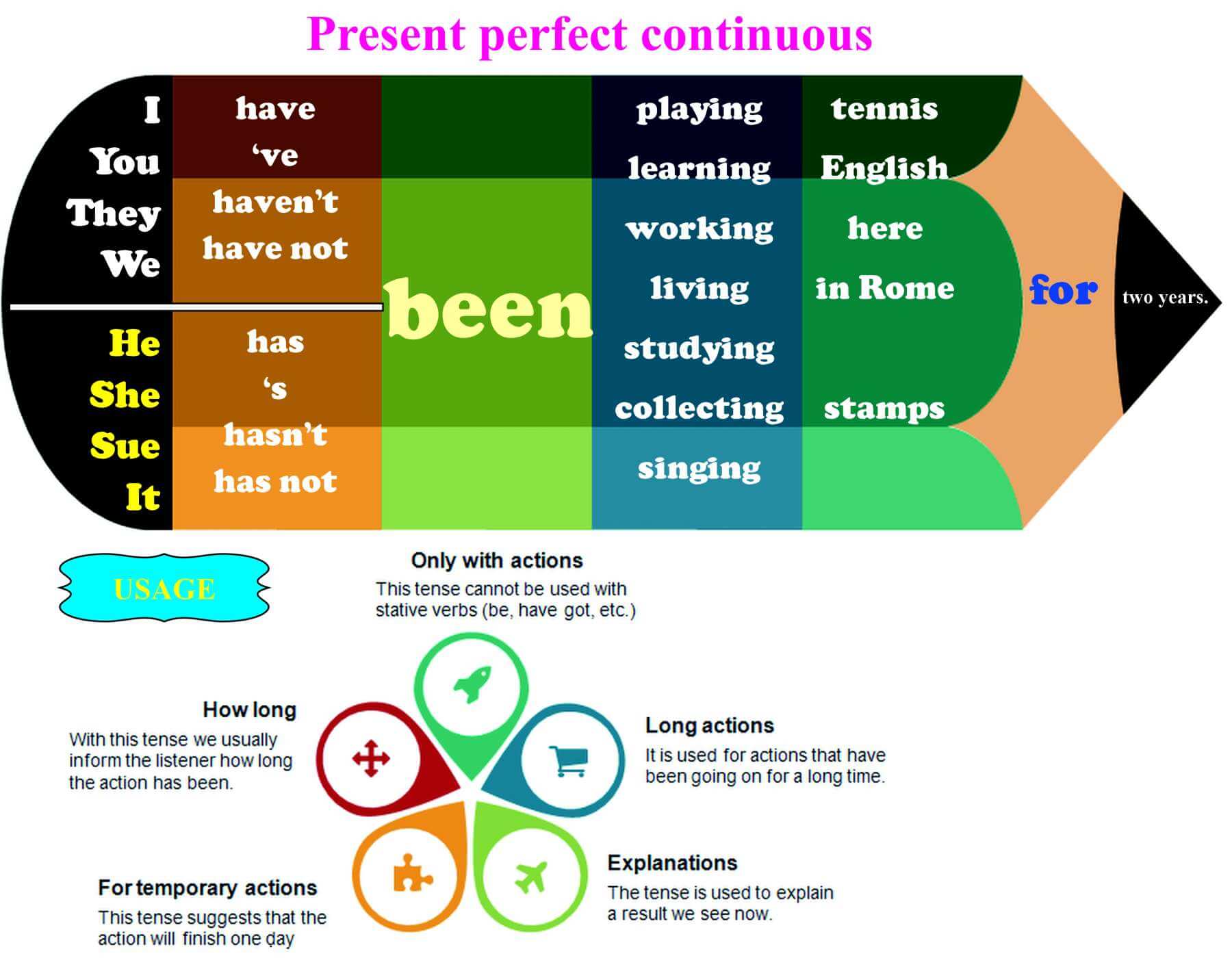
Then explain the usage of the tense.
Present perfect continuous – worksheet
Activity 1: Students look at their pictures and tell their partners whether they have been doing the activities in the pictures. If they say that they have been doing something, their partner immediately asks how long they have been doing it. In this way you ensure that the students listen to each other.
Activity 2: Students complete the exercise with present perfect simple or continuous.
Present perfect continuous worksheetPresent perfect continuous – quiz
Present perfect continuous – Links
The verb TO BE is the most important verb in English. Unfortunately, it is the most irregular verb in English, too. However, as all students of English manage to master its forms in the end, there is no reason to dispair. This mastery comes through practise.
In this post I would like to share with you several several exercises and games in which your students can practise the verb. There are about 90 different sentences in which students should use the verb TO BE. The vocabulary is limited so that students with a vocabulary of 100 words will be able to do the exercises.
In this post there is an infographic, a worksheet, an online quiz and two games. I hope it is enough and your students will learn the forms of the verb to be.
Verb to be – infographic

ADVERT:
[showmyads]
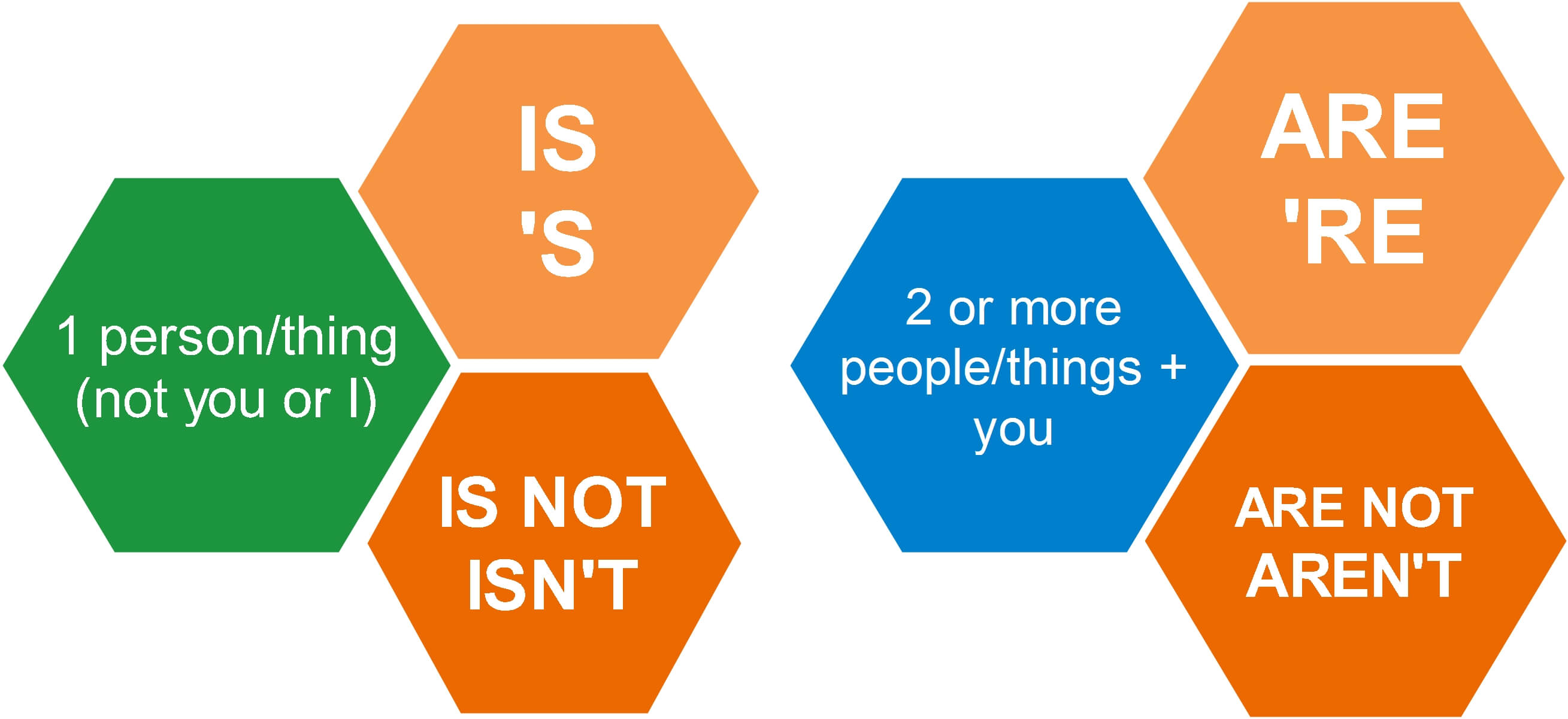
If you teach a monolingual group of elementary students it is a good idea to translate the second infographic.
Verb to be – worksheet
Verb to be – online quiz and games
The first game is called Penalty Shootout. In this game you should choose the correct form of the verb to be and then try to score a goal. Good luck.
As the game is in Flash, it will only play on desktop computers.
The second game is in Flash and will play only on desktop computers. It is called On Target, and your task is to choose the correct option and then shoot all the bad cows and ducks. You can shoot one of the bottles on the wall to get a bonus. Enjoy.
Verb to be – On Target gameVerb to be – links
If your students do not know the adjectives used in this post, there is great song teaching the adjectives by my friend Jules from English Through Music Madrid.

